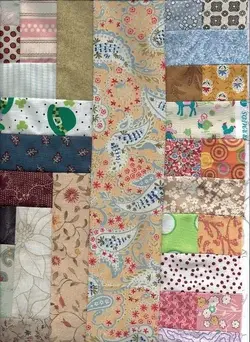freedombecki
Let's go swimmin'!
- Thread starter
- #161
From the XXX Arts thread, I quickly did this one:
It later occurred to me, it would make a good "sampler" work to make a small sample of my work in order to gauge the time it takes to do a small quilt, and on that basis, calculate a minimum wage + social security benefit I would have to use as an asking price to sell this particular size of postage stamp quilt work. I used uneven numbers in the makeup on purpose because to get a point, you have to have one square. If the piece were symetric and you tried to use an even number, you would be headed for trouble or a nonpoint work, or one so large, you'd have to make it the size of a football field to get the point effect. Honest.
uneven number to center postage stamp object:
It later occurred to me, it would make a good "sampler" work to make a small sample of my work in order to gauge the time it takes to do a small quilt, and on that basis, calculate a minimum wage + social security benefit I would have to use as an asking price to sell this particular size of postage stamp quilt work. I used uneven numbers in the makeup on purpose because to get a point, you have to have one square. If the piece were symetric and you tried to use an even number, you would be headed for trouble or a nonpoint work, or one so large, you'd have to make it the size of a football field to get the point effect. Honest.
uneven number to center postage stamp object:
X
XXX
XXXXX
XXXXXXX
XXXXX
XXX
X
XXX
XXXXX
XXXXXXX
XXXXX
XXX
X
Even numbers have their place, too, particularly when you are trying to make your square conform to the quilter's 12" finished square idea for group project items whereby the newest quilter is required to put the blocks together, since she doesn't know that not every quilter will produce a square that measures an exact twelve inches when she is done. 
OK, just for illustrative purposes, here's a square that under the right given measurement might equal twelve inches finished at the end of the day:

OK, just for illustrative purposes, here's a square that under the right given measurement might equal twelve inches finished at the end of the day:
XX
XXXX
XXXXXX
XXXXXXXX
XXXXXXXXXX
XXXXXXXXXXXX
XXXXXXXXXX
XXXXXXXX
XXXXXX
XXXX
XX
See? You may get 12" if you play your cards right, but akkkk! There's no sharp point in the second figure. And even in the second figure, you're using flattened squares if you even come close to 12 inches finished, which would exacerbate any thought of having a point, except perhaps horizontally
Now, I'm gonna go try and eke out the first illustration in postage stamps, to see if it comes out okay on the printer to get the visualization out to the people who read this thread occasionally but do not say anything.
Ok, the first one is 7 high and 7 wide. So let me do a little math on my 'puter's calculator to get answers for
a 1.25" x 7 (width) = 8.75 inches
b 1.25" x 7 (heighth) = also 8.75 inches.
12 - 8.75 = 3.25 inches
So I will need 3.25 + .5 = 3.75" strips to accommodate a seam allowance all the way around the 8.75 + .5 = 9.25 theoretical unfinished size
This makes it a perfect unfinished 12.5" size to finish out at 12" in an overall quilt.
I'll try to make a sample that measures the 9.25" size. Hey, that's a potholder or a miniature wallhanging!
XXXX
XXXXXX
XXXXXXXX
XXXXXXXXXX
XXXXXXXXXXXX
XXXXXXXXXX
XXXXXXXX
XXXXXX
XXXX
XX
See? You may get 12" if you play your cards right, but akkkk! There's no sharp point in the second figure. And even in the second figure, you're using flattened squares if you even come close to 12 inches finished, which would exacerbate any thought of having a point, except perhaps horizontally

Now, I'm gonna go try and eke out the first illustration in postage stamps, to see if it comes out okay on the printer to get the visualization out to the people who read this thread occasionally but do not say anything.
Ok, the first one is 7 high and 7 wide. So let me do a little math on my 'puter's calculator to get answers for
a 1.25" x 7 (width) = 8.75 inches
b 1.25" x 7 (heighth) = also 8.75 inches.
12 - 8.75 = 3.25 inches
So I will need 3.25 + .5 = 3.75" strips to accommodate a seam allowance all the way around the 8.75 + .5 = 9.25 theoretical unfinished size
This makes it a perfect unfinished 12.5" size to finish out at 12" in an overall quilt.
I'll try to make a sample that measures the 9.25" size. Hey, that's a potholder or a miniature wallhanging!



























